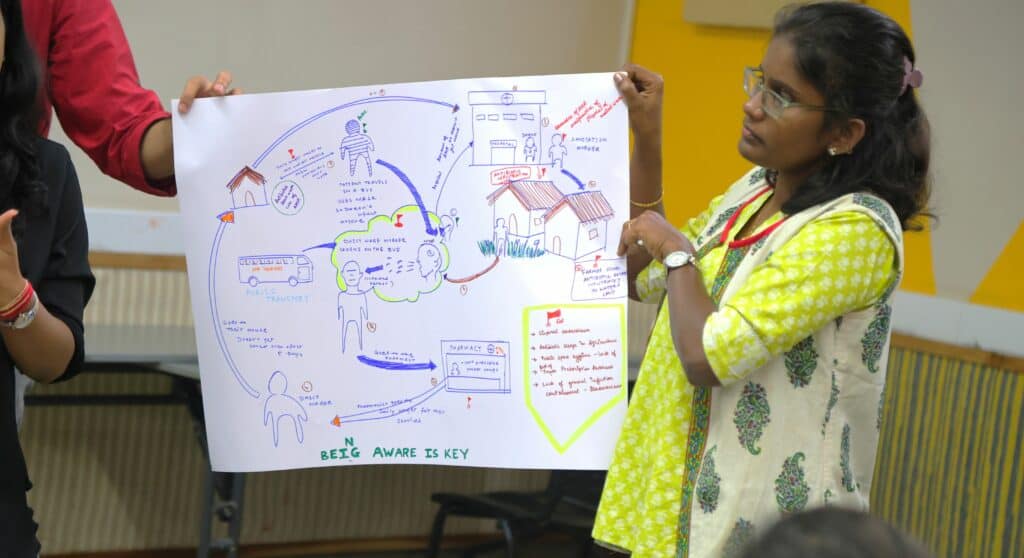World AMR Awareness Week (WAAW) 2025 is here, and every year it reminds us of the same thing. Despite the threat of AMR only increasing, it is still not a regular part of India’s public conversation, and even the limited media reporting we do have often overlooks the communities, systems and pressures that shape it.
On 4 November 2025, at the 3rd Science Journalists Association of India conference, we had the chance to explore this with a room full of journalists and communicators. The theme of the conference was Solutions Journalism, which made the conversation even more relevant. You cannot report on solutions unless you understand the whole problem, and in the case of AMR, our understanding is still taking shape.
We grounded the session with two simple exercises. One mapped the journey of an antibiotic from lab to land. The other traced how an infection moves from one person to many. Everyone sketched these journeys by hand, marking the points where things break down. Then we asked them to see the story through the eyes of a pharmacist, a sanitation worker, a farmer, a daily wage worker, a doctor and patient navigating the health system, or a family living near pharma effluents or in an unsanitary environment. The moment they shifted their gaze, the story changed.

What emerged on paper was far removed from the usual idea that AMR is caused by people misusing antibiotics. We saw sanitation workers handling untreated medical and pharmaceutical waste, often without adequate protection. Farmers depending on antibiotics because food systems leave them few choices. Workers who cannot afford to lose a day’s wages and pick up partial courses to get through the week. Patients moving between hospitals, informal providers and chemists, trying to make sense of an unpredictable system. Families living in environments where infections keep coming back. Add gender and caste into this picture and AMR suddenly looks less like a clinical issue and more like a social, structural and economic one.
These realities rarely make it into mainstream reporting. And the reasons, as the group also shared, are clear. Given the current scientific and clinical focus, AMR often feels too technical to pitch. Editors do not always see it as urgent. It is hard to find human stories or strong visuals. Accessing reliable data on antibiotic use, AMR patterns or pharmaceutical waste is difficult. Responsibility is scattered across ministries, sectors and industries, which makes accountability harder to trace. Newsrooms rarely have the time or training to support cross sector stories that sit at the intersection of health, environment, labour and policy. Even when journalists want to cover AMR, the system around them does not always make it easy.
On top of this, our coverage often follows global narratives. International reports focus on overuse, behaviour, stewardship and drug pipelines. These matter a great deal, but when we lift these frames directly into the Indian context, we lose sight of the local pressures and inequities that shape AMR long before it shows up in a lab report. The crisis looks very different when seen from the vantage point of a sanitation worker or a town or village near a pharmaceutical cluster.
This is where Solutions Journalism becomes essential. You cannot report on what works without understanding for whom it should work, and what conditions shape their choices. Good solutions reporting requires a deep understanding of the communities most affected, the gaps in systems and regulation, and the lived experience of AMR, not only the clinical one.
As we wrapped up the session, the theme of WAAW2025, Act Now: Protect Our Present, Secure Our Future, felt especially relevant. It is a call to action that only makes sense when we understand the full story of AMR, including the lives and realities that rarely appear in coverage. If our reporting is narrow, our solutions will be narrow too.
At Superheroes Against Superbugs, we love talking about microbes and will continue to do so. But we also know that the AMR crisis in India is not only about microbes and antibiotics. It is also about inequities, labour, the environment, broken infrastructure and the quiet compromises people make when they do not have the support they need. These are the stories waiting to be told, and they may be the key to imagining meaningful change.
We look forward to continuing this work with SJAI. If you are a journalist or communicator thinking about these gaps or exploring new ways to report on AMR, we would love to hear from you.
This WAAW2025, let’s widen the frame and make the story more honest. Only then can we understand the challenge before us, and the solutions that are possible.
